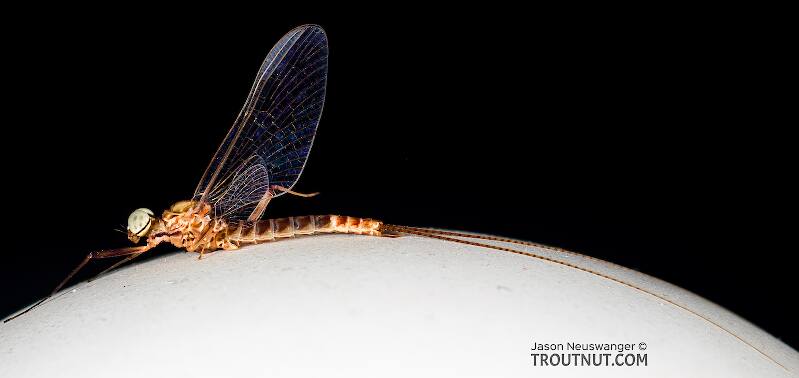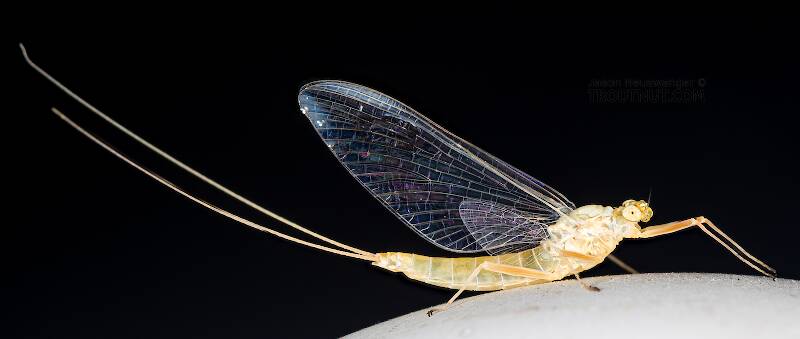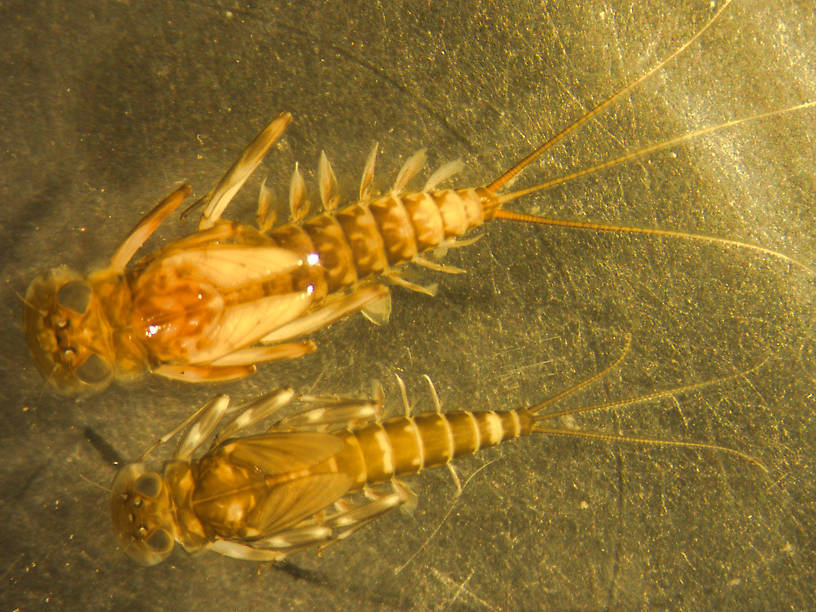
Salmonflies
Pteronarcys californica
The giant Salmonflies of the Western mountains are legendary for their proclivity to elicit consistent dry-fly action and ferocious strikes.

Mayfly Species Ecdyonurus criddlei (Little Slate-Winged Duns)
Where & when
This is one of the most widely distributed of the former Heptagenia species in the West, including the rivers along the Pacific Northwest coast.In 24 records from GBIF, adults of this species have mostly been collected during September (38%), October (17%), August (17%), July (17%), and June (8%).
In 25 records from GBIF, this species has been collected at elevations ranging from 1450 to 9318 ft, with an average (median) of 6270 ft.
Species Range
Hatching behavior
Water temperature: 54°F for good hatches
Physical description
Most physical descriptions on Troutnut are direct or slightly edited quotes from the original scientific sources describing or updating the species, although there may be errors in copying them to this website. Such descriptions aren't always definitive, because species often turn out to be more variable than the original describers observed. In some cases, only a single specimen was described! However, they are useful starting points.
Male Spinner
Wing length: 7-8 mm
Summary: Mesonotum deep black-brown; deep brown lateral patches on tergites, lateral dark streaks on sternites; fore legs short, deep purple-brown; genitalia of the Ecdyonurus simplicioides type.
Head dark olive brown; tinges of paler ochreous behind ocelli and at bases of antennae. Thorax deep black-brown; sutures of pleura marked with ochreous. Fore legs very deep purple-brown, slightly paler at base; tibia slightly longer than femur, tarsus and tibia subequal; individual joints of tarsus short, basal joint about 1/3 as long as second, which is subequal to third and fourth. Middle and hind legs somewhat paler than fore legs; basal joint of hind tarsus distinctly longer than second. Wings hyaline, venation light brown; cross veins very fine, not at all thickened; costal cross veins before the bulla very thin and few in number.
Abdominal segments light clay-color. Tergites with deep brown semi-rectangular patches on each side, extending anteriorly and laterally from the posterior margin, but not attaining the anterior margin except on 1 and 2, where almost the entire segment is occupied by these patches. Sternites with lateral longitudinal brown streaks or bands "adjoining the suture" (next to pleural fold?); in our specimens, ganglionic areas outlined in dark brown. Forceps and tails dull smoky. Genitalia of the Ecdyonurus simplicioides type (see fig. 96).
This species is distinguished from others allied to it by the short fore tarsi of the male, the fine cross veins and the abdominal pattern; the latter distinguishes it from H. otiosa, its nearest ally, which is more uniformly red-brown in color. (Update: H. otiosa is now a synonym of this species.)
Described as H. otiose
Body length 7 mm, wing length 7 mm
A dark-colored species of the H. simplicioides (now a syononym of Ecdyonurus simplicioides) group, allied to H. criddlei (now a synonym of E. criddlei).
Head and thorax rather dark reddish brown. A yellow streak on mesothorax anterior to wing root; two black dots on each coxa; a short black streak anterior to middle coxa. Scutella and areas on each side of these, blackish. Fore leg quite short; tarsus subequal to tibia; deep purplish brown, femur somewhat paler at base. Middle and hind legs reddish brown; tibia somewhat paler than femur; tarsus smoky brown. Wings hyaline; veins fine, dark brown. Cross veins in basal costal space and between bulla and stigmatic area few in number and very indistinct. Abdominal segments red-brown; tergites shaded with purplish brown in posterior two-thirds; sternites slightly paler than tergites. Genitalia of the simplicioides type; quite similar to criddlei but with larger subapical spines near inner margin, and an additional small apical spine near outer margin.
Distinguished from criddlei by the details of genitalic structure noted above, as well as by the darker abdomen which lacks the dark markings of that species.
Described as H. rosea
Body length 7 mm, wing length 7 mm
Mesonotum pale reddish brown; abdominal tergites largely purplish rose; genitalia of the H. simplicioides type (now a synonym of Ecdyonurus simplicioides).
Head purplish; antennae purplish, pale at tips. Pronotum reddish brown washed with purplish. Mesonotum pale reddish brown; scutellum paler, but margined narrowly with purplish brown. Metanotum similar in color, its median projection pale; posterior portion darker. Pleura reddish brown, with no dark markings; sternum similar to mesonotum. Middle and hind legs yellowish amber; middle femur with a reddish apical streak on ventral edge; distal joints of all tarsi, claws and tarsal joinings smoky brown. Basal joint of hind tarsus slightly longer than second joint. Wings hyaline; longitudinal veins very pale yellowish to amber; cross veins colorless, almost invisible, except in costo-apical space. 4 to 5 basal costal cross veins, 10 to 12 beyond bulla.
Abdominal segments 1-6 semi-hyaline, apical segments opaque. Postero-lateral triangles and antero-median area of each tergite hyaline whitish, the latter tinged with rose; remainder of each tergite purplish rose, including the posterior margins. Intersegmental areas narrowly pale, so that abdomen appears somewhat annulate. Segments 7-10 washed with reddish brown; sternites 1-6 pale whitish tinged faintly with pink. Genitalia pale amber. Third joint of forceps considerably longer than the distal joint, these two together not quite as long as second joint. Penes with a median apical, apical and lateral lobes; two large median spines, unusually stout at base; on each side a small apical spine. Evidently allied to H. simplicioides (now a synonym for Ecdyonurus simplicioides), H. rubroventris (now a synonym of E. criddlei), and H. rodocki (now a synonym of E. simplicioides), from all of which it is distinguished by the single apical spine on each side of penes, and by the color pattern of the abdomen. In general appearance, close to H. perfida (now a synonym of Nixe perfida) and H. horrida (now a synonym of Nixe horrida); also to H. lucidipennis (now a synonym of Nixe lucidipennis), but differing in details of structure of penes. Tails pale amber in basal half, becoming pale smoky apically; joinings opaque, very faintly rose-colored. Penes as in fig. 98.
Described as H. rubroventris
Body length 7.5-8 mm, wing length 8 mm
Thorax yellow marked with reddish brown; abdomen largely reddish brown dorsally; wide mid-ventral band of red-brown on thorax and abdomen; genitalia of simplicioides (now a synonym of Ecdyonurus simplicioides) type (see fig. 98).
Head yellowish. Face sprinkled finely with minute dark specks; area at base of antennae brown; brown median streak on vertex. Bases of antennae pale; filament dusky, tips pale. Pronotum yellowish, with a wide blackish median stripe. A wide purplish-black longitudinal stripe above base of fore leg extending backward along pleura above bases of other legs, most prominent on prothorax. Mesonotum yellow, washed heavily with reddish brown anteriorly and on entire posterior margin, including scutellum; a faint reddish-brown median band is more or less evident; antero-lateral margin purplish black. Metanotum dark red-brown. Pleura yellow marked with red-brown, black streak above legs bases. Sternum pale yellow, with a prominent median purplish or reddish brown band. Fore femur yellow at base, remainder bright reddish brown with purplish tinge; apex narrowly black. Tibia pale yellowish in basal portion, distinctly tinged with smoky apically; tarsus pale smoky grey, terminal joint and joinings narrowly darker. Basal joint of fore tarsus 1/4 to 1/3 of second; tarsus distinctly longer than tibia. Middle and hind femora pale yellowish, marked only on dorsal apical margin with faint reddish tinge; tibiae pale, sometimes faintly smoky; terminal tarsal joint and claw purplish grey, other joints often tinged with smoky; joinings narrowly dark; basal joint as long as or very slightly longer than second joint. Wings with a distinct milky cloud in stigmatic area, faintly milky before bulla in first two spaces, sometimes entire wing with faint milky tinge. Costa, subcosta and radius yellowish; costa sometimes brownish beyond bulla. Other longitudinal veins fine, blackish brown; cross veins pale, almost invisible, especially in costal space before bulla, where there are usually 5 veins; 11 to 12 beyond bulla in costal space.
Abdominal segments 2-6 semi-hyaline; 7-10 opaque. A brown median band occupies all but extreme lateral area of all tergites; on 2-6 this is purplish brown with a tinge of red; on 7-10 bright red-brown, somewhat yellowish on 10. Within this dark band is a geminate darker median streak enclosing a narrow pale mid-dorsal line, and pale submedian lunate streaks on each side of the dark area. A dark ? mark separates the lateral edge of central dark band from the narrow pale lateral area above the pale pleural fold. Posterior margins of tergites 2-5 narrowly pale; of remaining tergites, dark red-brown. A wide purplish brown median band occupies most of sternites 1-5, is more restricted on 6 to 8, obsolescent on 9; lateral portions of 2-6 pale yellowish white; 7-9 yellow. Overlapping portions of sternites appear darker in area of dark median band. Within the dark band on each sternite are two pale dots, one on each side of median line near center of sternite, and two pale oblique submedian dashes from anterior margin, forceps base yellow; forceps smoky, darkest at tip of second joint. Penes much as in simplicioides.
The wide purple-brown mid-ventral band distinguishes this species from others previously described. In type of genitalia it is allied to H. simplicioides (now a synonym of Ecdyonurus simplicioides), also to H. rosea (now a synonym of E. criddlei), H. rodocki (now a synonym of E. simplicioides), and H. criddlei (now a synonym of E. criddlei).
Female Spinner
Wing length: 8 mm
Female very similar to male. Reddish brown areas at bases of ocelli; reddish patches between lateral ocelli and eyes, connected by a faint reddish transverse band; a wide reddish area at center of posterior margin and a median dark streak on vertex connecting this band and the transverse line. Dorsal abdominal band much more restricted than in male; ventral dark band present, on thorax, almost obsolescent, on abdomen. Cross veins of wing faintly dark except in costal area.
Specimens of the Mayfly Species Ecdyonurus criddlei
1 Male Spinner

58: Male penes distinctly L-shaped; Segment 1 of foretarsi usually 1/3 to 2/3 the length of segment 2
58': Males penes not distinctly L-shaped; Segment 1 of foretarsi usually 1/5 to 1/2 the length of segment 2
The characteristics conflict here, as I'd say the penes ARE L-shaped, but the fore tarsal ratio is less than 1/3. Maybe the weasel word "usually" allows for that, and it's some kind of Stenonema, for which I'm not aware of any records in Montana, let alone western Montana.
Going by the tarsal ratio and assuming it's not Stenonema, everything in couplet 60 points to Afghanurus: contiguous compound eyes, genitalia similar to fig 13.222 in MC&B, and weakly developed basal costal crossveins in the forewings. But I looked up the original descriptions of the three Afghanurus species, and the body sizes (flowersi 5-7 mm, inconspicua 4 mm, joernensis 6-7 mm) are way below this one's 10 mm.
This led me to notice that the closely related Ecdyonurus is not included in the key at all, so I checked the descriptions of those species and found that Ecdyonurus criddlei fits very well: the color of the legs, the markings on the tergites and sternites, the short fore tarsus and ratios of the segments, etc. It was originally described as 7 mm, smaller than the 10 mm body of this specimen, but synonyms have been described with larger sizes including wing lengths up to 11 mm for females for Heptagenia salvini.
This specimen was found with a female nearby, which I think is probably the same species, although it is difficult to be certain.
1 Female Spinner

1 Nymph

Start a Discussion of Ecdyonurus criddlei
References
- Arbona, Fred Jr. 1989. Mayflies, the Angler, and the Trout. Nick Lyons Books.
- Caucci, Al and Nastasi, Bob. 2004. Hatches II. The Lyons Press.
- Knopp, Malcolm and Robert Cormier. 1997. Mayflies: An Angler's Study of Trout Water Ephemeroptera . The Lyons Press.
- Needham, James G., Jay R. Traver, and Yin-Chi Hsu. 1935. The Biology of Mayflies. Comstock Publishing Company, Inc.
Mayfly Species Ecdyonurus criddlei (Little Slate-Winged Duns)
Species Range
Common Name
Resources
- NatureServe
- Integrated Taxonomic Information System
- Global Biodiversity Information Facility
- Described by McDunnough (1927)


